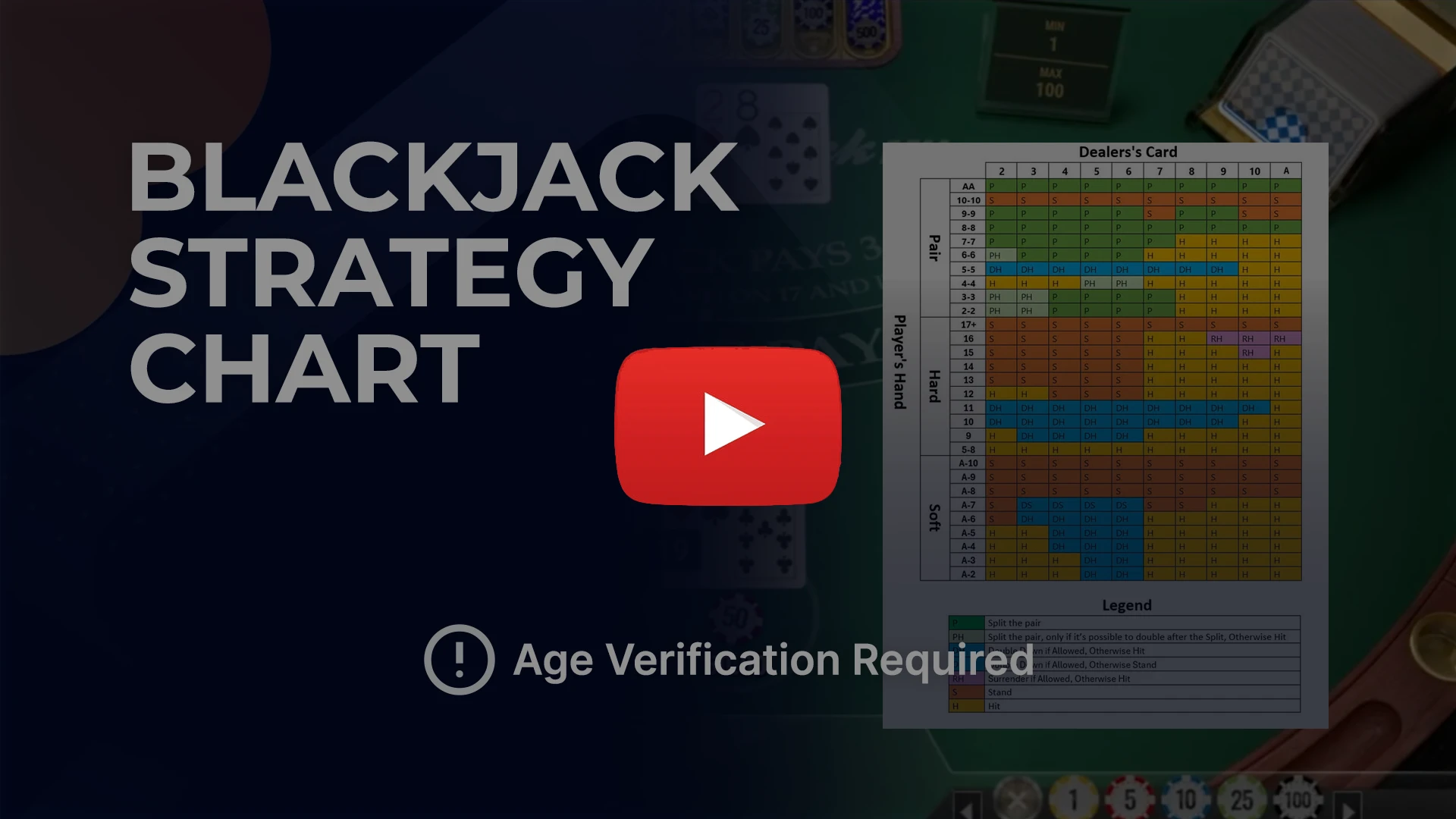
Blackjack Strategy Chart
Blackjack Strategy Charts: Your Winning Guide
Blackjack is a game of skill and strategy. Using the right tools and making informed decisions significantly improves your chances of winning. One essential tool for any serious blackjack player is the strategy chart, often called a cheat sheet.
This article guides you through what a strategy chart is, how to read and use it, and the legalities of using it at a blackjack table. We'll also provide practical tips to help you master these charts and enhance your gameplay.
What is a Blackjack Strategy Chart?
A blackjack strategy chart is a visual tool that helps players make optimal decisions in every possible scenario during a game. It is based on statistical probabilities and mathematical models, minimizing the house edge and maximizing the player’s chances of winning. Presented in table form, it guides players on whether to hit, stand, double down, split, or surrender, depending on the cards in play.
- Usefulness: A blackjack chart guides players to make optimal decisions, reducing the casino's advantage. It eliminates guesswork and emotional decisions, ensuring each move is based on statistical analysis and proven strategy.
- When to Use: Crucial for making quick and accurate decisions during gameplay, it helps you determine whether to hit or stand, decide when to split pairs, know the optimal times to double down, and choose if and when to surrender.
Blackjack Basic Strategy Chart: Stand / Hit
Determining whether to hit or stand is a fundamental aspect of basic Blackjack strategy, and using a Hit & Stand chart helps make this decision with confidence.
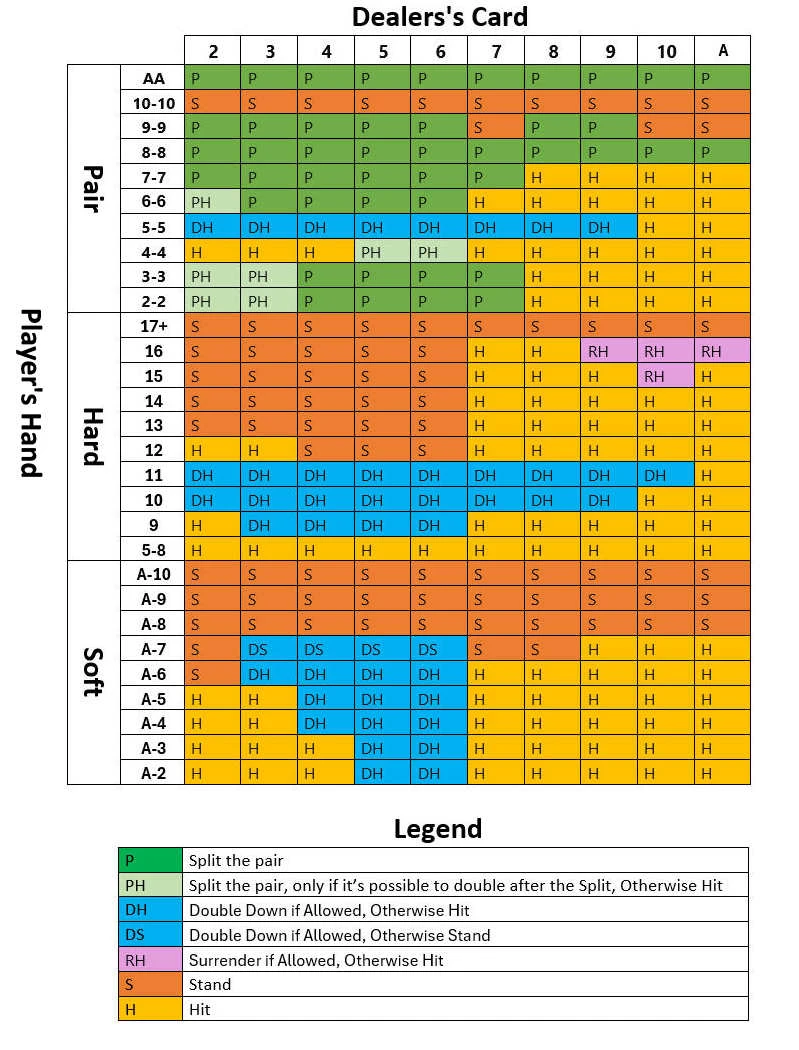
This table is useful to answer the question: Should I hit or should I stand?
Example: You have a total of 12, and the dealer's upcard is a 3.
- Chart Recommendation: Hit (H).
- Explanation: According to the basic strategy chart, hitting on 12 against a dealer's 3 gives you the best chance of improving your hand without going bust.
If you want to learn more about this player decision you can read our article on When to Hit & Stand ?
Blackjack Split Chart
Knowing when to split pairs can significantly impact your success in Blackjack, and the split chart provides clear guidance on the best situations to do so.
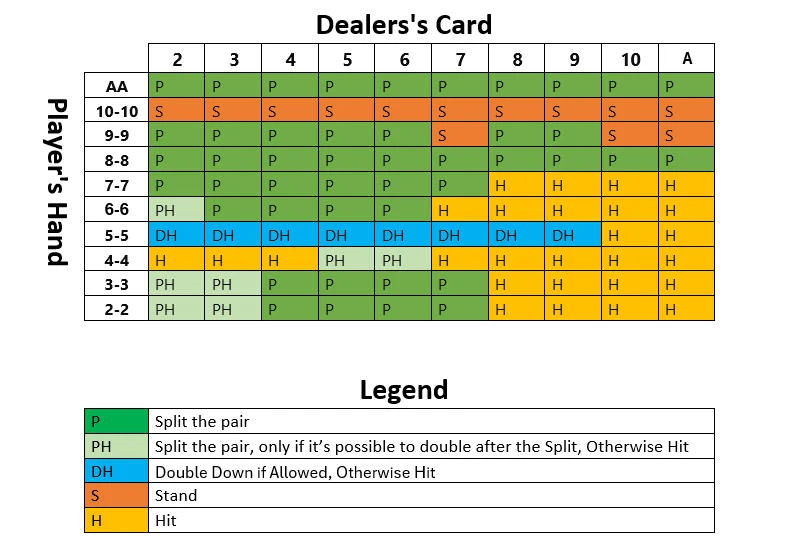
This chart is useful to answer the question: Can I/Should I Split?
Example: You have a pair of 8s, and the dealer's upcard is a 6.
- Chart Recommendation: Split (P).
- Explanation: The split chart indicates that splitting a pair of 8s against a dealer’s 6 is advantageous because it increases the likelihood of forming strong hands with each 8.
If you wish to delve deeper into the subject you can access our article on When to split in Blackjack ?
Blackjack Double down chart
Doubling down can maximize your winnings in favorable situations, and the double down chart helps identify the optimal times to take this bold move.
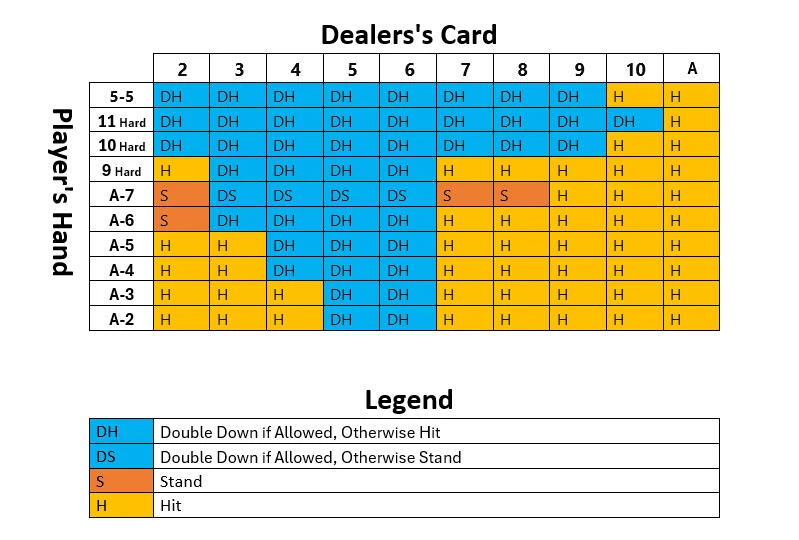
This table is useful to answer the question: Can I/Should I Double?
Example: You have a total of 11, and the dealer's upcard is a 5.
- Chart Recommendation: Double Down (D).
- Explanation: Doubling down on 11 against a dealer’s 5 is recommended by the double down chart because it maximizes your potential winnings when the odds are in your favor.
To go further, you can now read this article, which deals with when to use double down?
Blackjack Surrender Chart
Surrendering can be a smart move to minimize losses, and the surrender chart outlines the best scenarios to choose this option.
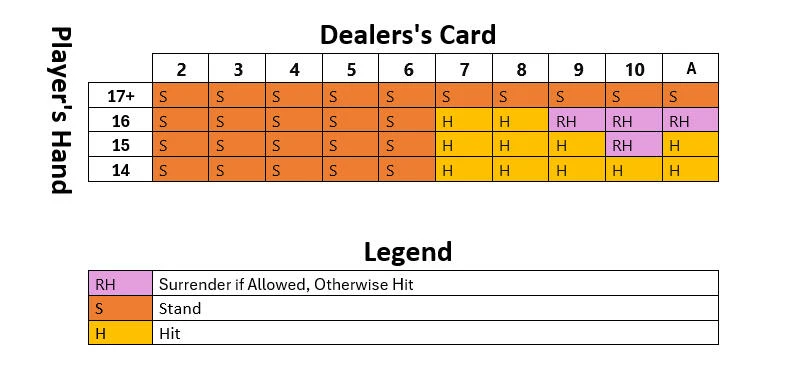
This tool is useful to answer the question: Can I/should I Surrender?
Example: You have a total of 16, and the dealer's upcard is a 10.
- Chart Recommendation: Surrender (R).
- Explanation: The surrender chart advises surrendering with 16 against a dealer’s 10 because the chances of winning this hand are low, and surrendering minimizes your losses.
If you want to learn more about this, check out our article on When to surrender in Blackjack?
How to Read Blackjack Charts?
Understanding how to read a chart is crucial for making informed decisions at the table and maximizing your chances of success.
Layout Explanation
Typically organized in a grid format with rows and columns. The layout is designed to be intuitive, allowing players to quickly find the recommended action based on their hand and the dealer's upcard.
- Rows: The rows represent the player’s hand totals. These are sometimes divided into three sections: hard hands, soft hands, and pairs. This is not the case for the simplest charts, but on the Stand & Hit one, further down this page, that we offer you, you can notice that this information is mentioned
- Columns: The columns represent the dealer’s upcard, ranging from 2 through Ace. The chart compares the player’s hand with the dealer’s upcard to suggest the best move.
Symbols and Abbreviations
Understanding the symbols and abbreviations is crucial for using the chart effectively. Here are the most common symbols:
|
Symbol |
Meaning |
|---|---|
|
H |
Hit: Take another card.
|
|
S |
Stand: Keep your current hand.
|
|
D(H) |
Double Down: Double your bet and receive only one more card.
|
|
D(S) |
Double Down if Allowed, Otherwise Stand.
|
|
P |
Split: Split your pair into two separate hands.
|
|
P(H) |
Split if Double After Split is Allowed, Otherwise Hit.
|
|
R(H) |
Surrender if Allowed, Otherwise Hit.
|
Key Elements
This kind of tool typically includes the following key elements:
- Player’s Hand Total: The chart lists possible totals of the player’s hand, including both hard and soft hands. A hard hand is one without an Ace counted as 11, while a soft hand includes an Ace counted as 11.
- Dealer’s Upcard: The dealer's visible card, or upcard, is a crucial factor in decision-making. The chart compares the player's hand total to the dealer’s upcard to suggest the best course of action.
- Actions: The recommended actions are usually represented by abbreviations or symbols such as H for Hit, S for Stand, D for Double Down, P for Split, and others. These actions are aligned with the player's hand and the dealer’s upcard.
Can You Use a Strategy Chart at a Blackjack Table?
When it comes to using a chart, the rules vary depending on whether you're playing online or in a physical casino.
- Online Blackjack: Strategy charts are allowed and encouraged in online Blackjack, providing a private setting where players can freely consult them to make informed decisions, enhancing the gaming experience.
- Physical Casinos: While using a strategy chart is not illegal in physical casinos, it is often discouraged, and players may be asked to put it away. Instead, memorising the chart beforehand is recommended to enhance your strategic play.
Is it Illegal to Use a Blackjack Chart or Not? In summary, while using a chart is widely accepted and legal in online Blackjack, physical casinos have a more conservative stance, preferring that players do not use visible aids at the table.
What About the Blackjack Deviations?
Blackjack deviations involve adjustments to the basic strategy based on specific game circumstances, especially when card counting. There are two types of deviations:
- Playing Deviations: Adjustments to standard strategy recommendations based on the remaining card count. For example, normally hitting on a hard 16 against a dealer's 10 may change to standing if the count is positive, indicating more high cards left.
- Betting Deviations: Adjustments to bet sizes based on the card count. For instance, increasing bets when the count is positive to capitalise on favourable odds.
The purpose of deviations is to exploit changing odds and increase profitability. Advanced players use deviations to refine their strategy, often going against the basic charts. Deviations require significant practice and a strong understanding of both basic strategy and card counting.
Tips for Using Blackjack Charts
- Mistakes to Avoid: Don't rely on the chart without understanding the strategy behind it, as this can limit your adaptability.
- Practice Makes Perfect: Regularly practice using the chart in online games or simulations to improve your speed and confidence in decision-making.
- Memorize it Perfectly: Memorize the chart to enhance your gameplay flow, especially in settings where using a chart openly isn't allowed.
- Staying Consistent: Consistently follow the chart’s recommendations to maintain its effectiveness and avoid undermining its statistical advantage.
Our opinion
Mastering Blackjack involves understanding and applying the right strategies, and a Blackjack chart is an invaluable tool in this pursuit. By using a strategy chart, you can make informed decisions on whether to hit, stand, split, double down, or surrender. These tools are especially helpful for both beginners and experienced players looking to improve their game and maximize their chances of winning. Uusing a Blackjack strategy chart is essential for anyone serious about playing the game. It not only helps you play more effectively but also boosts your confidence at the table. Embrace these tools, practice consistently, and watch your Blackjack skills and success rate improve.
Check out our finest selection of blackjack casinos to see how effective these betting techniques can be.

Author
Content Writer
